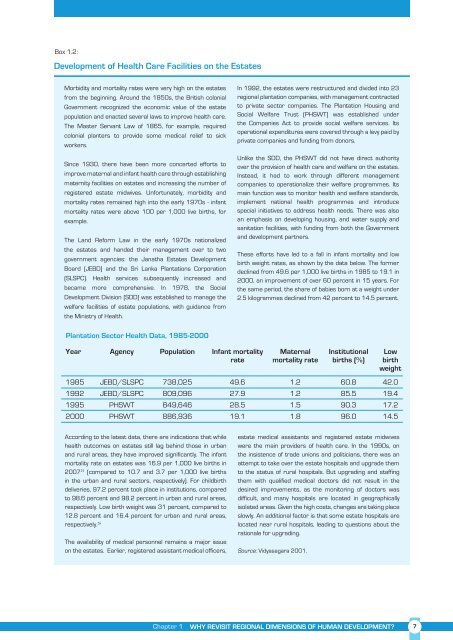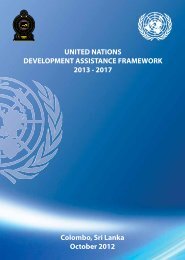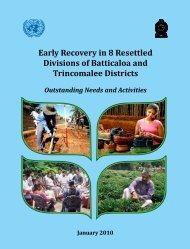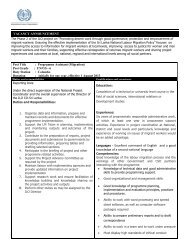Sri Lanka Human Development Report 2012.pdf
Sri Lanka Human Development Report 2012.pdf
Sri Lanka Human Development Report 2012.pdf
You also want an ePaper? Increase the reach of your titles
YUMPU automatically turns print PDFs into web optimized ePapers that Google loves.
Box 1.2:<br />
<strong>Development</strong> of Health Care Facilities on the Estates<br />
Morbidity and mortality rates were very high on the estates<br />
from the beginning. Around the 1850s, the British colonial<br />
Government recognized the economic value of the estate<br />
population and enacted several laws to improve health care.<br />
The Master Servant Law of 1865, for example, required<br />
colonial planters to provide some medical relief to sick<br />
workers.<br />
Since 1930, there have been more concerted efforts to<br />
improve maternal and infant health care through establishing<br />
maternity facilities on estates and increasing the number of<br />
registered estate midwives. Unfortunately, morbidity and<br />
mortality rates remained high into the early 1970s - infant<br />
mortality rates were above 100 per 1,000 live births, for<br />
example.<br />
The Land Reform Law in the early 1970s nationalized<br />
the estates and handed their management over to two<br />
government agencies: the Janatha Estates <strong>Development</strong><br />
Board (JEBD) and the <strong>Sri</strong> <strong>Lanka</strong> Plantations Corporation<br />
(SLSPC). Health services subsequently increased and<br />
became more comprehensive. In 1978, the Social<br />
<strong>Development</strong> Division (SDD) was established to manage the<br />
welfare facilities of estate populations, with guidance from<br />
the Ministry of Health.<br />
In 1992, the estates were restructured and divided into 23<br />
regional plantation companies, with management contracted<br />
to private sector companies. The Plantation Housing and<br />
Social Welfare Trust (PHSWT) was established under<br />
the Companies Act to provide social welfare services. Its<br />
operational expenditures were covered through a levy paid by<br />
private companies and funding from donors.<br />
Unlike the SDD, the PHSWT did not have direct authority<br />
over the provision of health care and welfare on the estates.<br />
Instead, it had to work through different management<br />
companies to operationalize their welfare programmes. Its<br />
main function was to monitor health and welfare standards,<br />
implement national health programmes and introduce<br />
special initiatives to address health needs. There was also<br />
an emphasis on developing housing, and water supply and<br />
sanitation facilities, with funding from both the Government<br />
and development partners.<br />
These efforts have led to a fall in infant mortality and low<br />
birth weight rates, as shown by the data below. The former<br />
declined from 49.6 per 1,000 live births in 1985 to 19.1 in<br />
2000, an improvement of over 60 percent in 15 years. For<br />
the same period, the share of babies born at a weight under<br />
2.5 kilogrammes declined from 42 percent to 14.5 percent.<br />
Plantation Sector Health Data, 1985-2000<br />
Year Agency Population Infant mortality Maternal Institutional Low<br />
rate mortality rate births (%) birth<br />
weight<br />
1985 JEBD/SLSPC 738,025 49.6 1.2 60.8 42.0<br />
1992 JEBD/SLSPC 809,096 27.9 1.2 85.5 19.4<br />
1995 PHSWT 849,646 28.5 1.5 90.3 17.2<br />
2000 PHSWT 886,936 19.1 1.8 96.0 14.5<br />
According to the latest data, there are indications that while<br />
health outcomes on estates still lag behind those in urban<br />
and rural areas, they have improved significantly. The infant<br />
mortality rate on estates was 16.9 per 1,000 live births in<br />
2007 25 (compared to 10.7 and 3.7 per 1,000 live births<br />
in the urban and rural sectors, respectively). For childbirth<br />
deliveries, 97.2 percent took place in institutions, compared<br />
to 98.6 percent and 98.2 percent in urban and rural areas,<br />
respectively. Low birth weight was 31 percent, compared to<br />
12.8 percent and 16.4 percent for urban and rural areas,<br />
respectively. 26<br />
The availability of medical personnel remains a major issue<br />
on the estates. Earlier, registered assistant medical officers,<br />
estate medical assistants and registered estate midwives<br />
were the main providers of health care. In the 1990s, on<br />
the insistence of trade unions and politicians, there was an<br />
attempt to take over the estate hospitals and upgrade them<br />
to the status of rural hospitals. But upgrading and staffing<br />
them with qualified medical doctors did not result in the<br />
desired improvements, as the monitoring of doctors was<br />
difficult, and many hospitals are located in geographically<br />
isolated areas. Given the high costs, changes are taking place<br />
slowly. An additional factor is that some estate hospitals are<br />
located near rural hospitals, leading to questions about the<br />
rationale for upgrading.<br />
Source: Vidyasagara 2001.<br />
Chapter 1 WHY REVISIT REGIONAL DIMENSIONS OF HUMAN DEVELOPMENT 7






